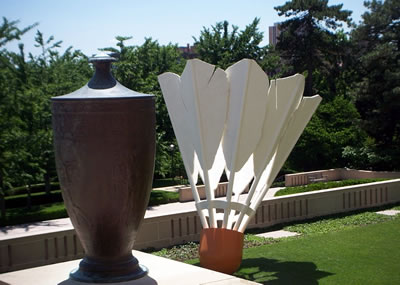 |
 |
 |
|
News & Notices
News From:
Conference & Stage Expo
For the Record
 |
Shuttlecocks, displayed on the lawn of the Nelson Atkins Art Museum in Kansas City, Missouri were created by Claes Oldenburg, and Coosje van Bruggen and fabricated by Merrifield-Roberts, Inc. in 1994. Made of aluminum, fiberglass-reinforced plastic, and painted, the four pieces can be seen at the museum, near the campus of the University of Missouri-Kansas City. Photo/Barbara E.R. Lucas |
|
|
History, Art Abound
in Kansas City
Fifteen million people died in World War I. This sobering fact brought Kansas City civic and business leaders together within two weeks of the November 11, 1918 armistice with a drive to create something to honor those who had served in the war and the millions who died. They created the Liberty Memorial Association in 1919 and, in just 10 days, raised a staggering $2.5 million (nearly $39 million today). The winner of the design competition for the memorial was Harold Van Buren Magonigle, sculpted by Robert Aitken, approaches designed by Wight & Wight, with park and landscaping by George Kessler. The 1921 dedication was attended by General Jacques of Belgium, Admiral Beatty of Great Britain, General Diaz of Italy, Marshal Foch of France, and General John “Jack” Pershing of the United States. Strangely, this was the only time these war leaders were ever together. The prominent highlight of the design is a 217-foot tower topped with an eternal flame. To the left and right of the tower are two small buildings which house WWI artifacts. It’s hard to miss the symbolism of the design – a giant, erect phallus with a flaming tip centered between a pair of testicles. But beginning in the 1960s, this monument became a powerful beacon for the gay sex trade and later the illegal drug trade. The monument fell into a state of disrepair and was closed for safety reasons in 1994. Work began to restore the monument and building as a world-class museum. The metropolitan area voted for a half cent sales tax measure in 1998. In 2004 Congress dedicated the Liberty Memorial as the national WWI memorial, and in 2006 a restored monument with a new, huge underground museum opened as the National WWI Museum. It is a stunning experience to visit, and can easily be reached by walking directly south of the convention center for about 30 minutes. The erect tower in the sky will the your guide. The “Eternal Flame” hasn’t been that eternal. The significant cost of operating it has put it on a limited schedule, but at night, it is quite amazing. And it is a theatrical trick: lighting and steam give the compelling impression of fire from the tip. One would think AIDS would have put an end to the nighttime adventures in the park, but no, it took the Patriot Act and the 2008 opening of the new Federal Reserve Bank of Kansas City across the street to clean it up. Under heightened security concerns, the gay sex and drug trade in the park came to an end. Another “must see” attraction in Kansas City is the Nelson-Atkins Museum of Art. Opening in 1933 with a classical Beaux-Arts architectural style, it has been internationally known for its extensive collection of Asian art. In 2007 a massive addition opened, known as the Bloch Building (after H&R Block co-founder Henry Bloch). This new complex was designed by architect Steven Holl and was ranked by Time magazine as number one on its list of “The Ten Best (New & Upcoming) Architectural Marvels.” With the opening, Henry & Marion Bloch donated their amazing collection of French Impressionist paintings, and the Hall Family and Hallmark cards donated a massive and world-class historical collection of photography. This November, the Sosland Family donated a stunning collection of American Indian art from the Pacific Northwest, which will be part of the just-opened American Indian Collection featuring exceptional pieces from all North American cultures. What is fascinating in this collection is that both historical works and the work of living contemporary artists are displayed together. The Nelson Atkins is free to the public, and is accessible by taking the Main Street bus due south to around Cleaver Blvd. (47th Street) and then walking east a couple of blocks. During this USITT Conference & Stage Expo, on April 2 will be the first Friday of the month. There is an ongoing First-Friday in the Crossroads Arts District where dozens of artist studios, art galleries, and restaurants open their doors to several thousand people who roam, look, sample, and mingle. This is centered around 18th & Main Streets, directly south of the Convention Center, is free, and runs from about 7 to 9 p.m. Finally, a trip about 14 miles east to Independence, Missouri reveals the Harry S. Truman Presidential Library and Museum. The 33rd President was a fascinating, plain-speaking fellow, and this museum does an excellent job of portraying his decision-making process for two of the most significant issues of the 20th Century: the use of the atomic bomb to end World War II and his executive order to integrate the U.S. Military. This museum underwent extensive renovations in 2001 and was the first Presidential Library to feature a full-scale replica of the Oval Office. |
||
United States Institute for Theatre Technology, Inc.:
© 2009 Volume XLIX, Number 12